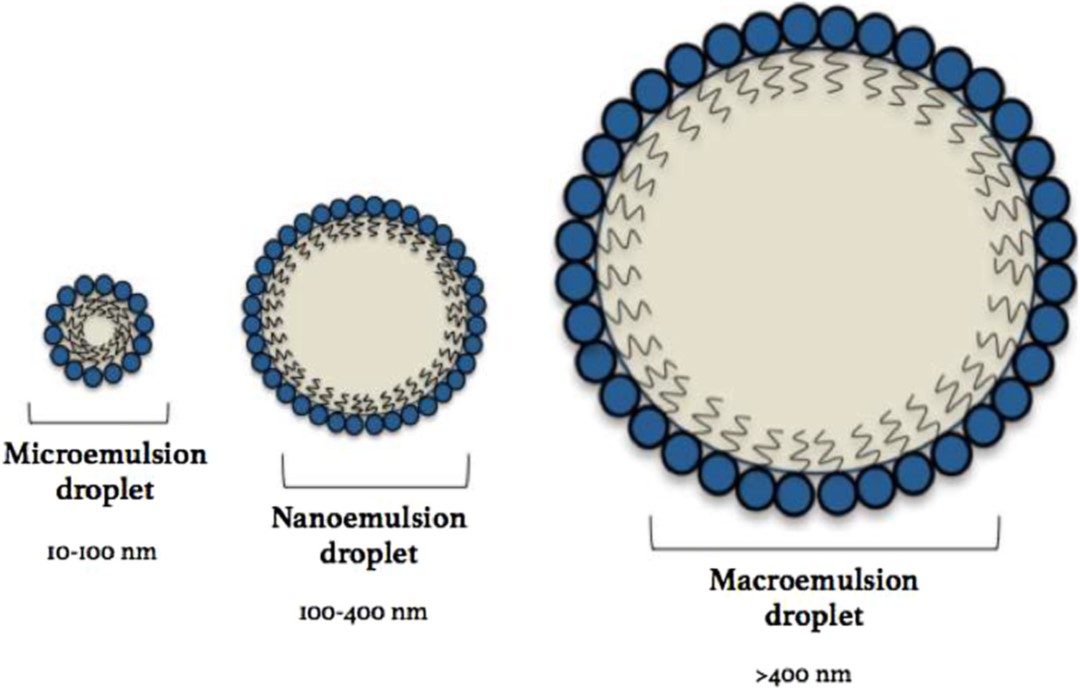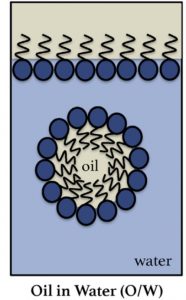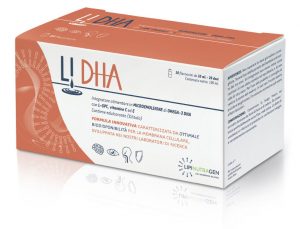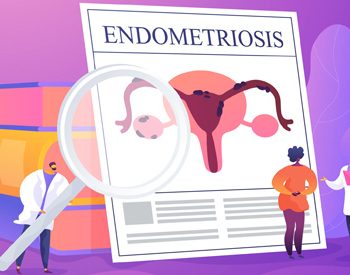
FORMS OF ADMINISTRATION IN NUTRACEUTICS

FROM SOFT-GEL CAPSULES TO MICROEMULSIONS
The research in the pharmaceutical field has addressed a crucial aspect of the efficacy of drugs and biologically active substances: the effective ability of administration (oral versus intramuscular and intravenous) to make the active ingredients bio-available rather disposal to enter into the bloodstream to reach the cellular/biological target on which the intervention it’s desired, to improve the subject’s state of health.
The so-called “soft-gel” capsules (“soft” capsules, as they were defined in an advertisement) are an example of administration (or pharmaceutical form), orally that has brilliantly resolved the loss of active substances in the stomach, as is the case for non-gastro-resistant tablets or capsules. The soft gel capsules are made of layers of gelatin (animal or vegetable) that contain the pharmaceutical or nutraceutical preparation, and the outer layers “flake” as they pass between the stomach and duodenum, releasing the active substances in the gastrointestinal tract where they can already be emulsified (as happens for the nutrients), to then be absorbed by the intestinal cells and start their path in the circulation reaching the target.
It should be emphasized that by improving bioavailability with soft-gel capsules, it was possible to use lower dosages of active substances, because the formulation becomes more “protected”, even with “delicate” active ingredients, and their presence in the circulation is more constant. Therefore, improvements in side effects were also found. Furthermore, in the soft gel capsule formulations have been created with substances of a very different nature, namely substances that dissolve in water together with substances insoluble in water, because they can “coexist” in the soft-gel capsule that acts as a container.
In this perspective of improving bioavailability, oral administration of liquids has returned, again for two reasons: 1) to protect better the active substances directly exposed to the action of gastric acidity, as in the case of vitamins, amino acids and peptides, o easily degradable/oxidizable molecules; 2) make hydrophilic and lipophilic substances coexist in the same formulation and allow their absorption.
EMULSION: WHAT IS IT ABOUT?
Inspired by what happens in nature, the emulsion is the typical liquid form in which substances of different nature coexist, and in it typical “drops” of different size are formed which contain the active ingredients and which are in suspension because each drop is wrapped in a layer of molecules (emulsifiers) that can “coexist” in both aqueous and non-aqueous environments (thus creating the water/oil suspension). One of the best known natural emulsions is milk. One of the emulsions we prepare in the kitchen is mayonnaise.
In the pharmaceutical or nutraceutical preparation, more detail has been given to the size of these drops or, thanks to the choice of ingredients called “emulsifiers”, microemulsions, nanoemulsions and macroemulsions can be obtained based on the size of the suspended particles.
Since 2011, the pharmaceutical industry and scientific research, given the glimpsed applicability of the use of this particular type of formulation, have worked hard on the subject, publishing more than 430 scientific releases in 5 years.
WHAT ARE THE MICROEMULSIONS?
Microemulsions, as the term already defines, indicate the mixture of two or more liquid ingredients that are immiscible with each other, that with the use of emulsifying agents and mixing by machinery, similar to a kitchen mixer, are able to form the drops that remain in suspension and therefore take on a homogeneous appearance, and providing a liquid appearance, sometimes even transparent.
The oil-water mixture (O/W) in microemulsions is obtained when the particles take on very small dimensions (from 10 to 100nm), because specific emulsifiers and stabilizers have been used, and they find that organization that brings them into equilibrium with the watery world that surrounds them.
Always observing nature, emulsified particles are always used to absorb substances (as happens in nutrition when chylomicrons are formed in the gastrointestinal tract). Furthermore, microvesicles are those that transport biological molecules such as vitamins, peptides, transmitters, hormones through the bloodstream and protect these delicate substances from degradation that would occur by the action of enzymes dissolved in the plasma or by the action of oxidants.
WHY CHOOSE A MICROEMULSION:
As studied in the pharmaceutical field, microemulsions improve the biodistribution of active ingredients, be they drugs or supplements. Let’s see the reasons for this improvement:
- as noted above for the soft-gel capsules, they improve the transition phases in the gastro-intestinal system and the protection from degradation, because the outer part of the vesicle resists the acidic environment, quickly passing into the gastro-intestinal tract of absorption;
- for microemulsions there is an additional advantage, which is expressed precisely at the moment of absorption, both intestinal and above all later in the passage into the cells of the target tissue. This is because the outer part of the vesicle closely resembles the lipid composition of cell membranes. In fact, cell membranes are made up of phospholipids that surround the cell allowing life to take place in an environment mainly made up of water, inside and outside the cell. The microvesicle that comes into contact with the cell membrane has a perfect compatibility of the molecular structure, so there is a progressive penetration into the phospholipid layer, up to bringing the whole vesicle inside the cell and obtaining both the penetration into the bloodstream and the subsequent release of the active substances when the vesicle will endup into the cellular target.
An advantage of microemulsions, above all forms of administration, is the swallowing facility of the liquid form, so a long and interesting evolution of this type of choice is expected when treating people who are not able to swallow (all the pediatric sector) or fragile.
In the microemulsion form we also see an easier “personalization” of the treatment, both because they can be dosed and because different formulations can be mixed together, thus allowing to obtain a “liquid and bioavailable strategy” of high precision.
This is ideal for the NUTRILIPIDOMIC strategy or the choice of the right type and dose for each molecular profile, that is the goal to which the 4 P MEDICINE (Preventive, Predictive, Personalized and Participatory) should aim.
INTEGRATION OF OMEGA-3 DHA
Polyunsaturated fatty acids are essential for the body, as explained several times in various articles of the LipiMagazine Blog (see further details).
In the research conducted by the Lipidomics Laboratory Lipinutragen regarding the lipidomic profiles of frail people (aging, pediatric deficits), the importance of docosahexaenoic acid DHA supplementation was highlighted, fatty acid of the omega-3 family, an important structural component of membranes and molecular element/precursor fundamental for countless cellular functions.
The moments in which it may be needed the intake of DHA are identifiable in the growth and development of the child or in neurological problems and broad-spectrum aging. Conditions affecting people who may be reluctant to take capsule preparations.
The topic of integrations in microemulsions under these conditions has become a nutraceutical project approved by the Evaluation Group of the Innovation Accelerators structure at the National Research Council, Research Area of Bologna, and has led to the birth of our R&D laboratory at the Accelerators. A research project was developed in collaboration with the University of Bologna as part of an Industrial Doctorate supported by Lipinutragen, and the results were used by the Lipinutragen R&D Division to develop the first preparation of omega-3 DHA in microemulsion to be made available on the nutraceutical market.
Li DHA, THE FIRST MICROEMULSION DHA
Li DHA is the first food supplement based on DHA in the form of a microemulsion, which is a product in liquid form that ensures quality and metabolic efficiency of the active ingredients. Li DHA has been specially designed to facilitate the absorption of DHA at the level of cell membranes, the site where the functions of DHA for the body are carried out.
The DHA raw material, carefully selected and contained in Li DHA, comes from a source of marine origin certified for the absence of contaminants and heavy metals. It is present in the form of triglycerides containing more than 97% of Omega-3 deriving from fish oil with a DHA concentration greater than 85% and with very low percentages of saturated fatty acids and almost no trans-fat.
Li DHA, being in liquid form, is easy to assume, ready to drink or to mix in a meal for an immediate combination with food.
Suitable for children from 6 months and for people with swallowing difficulties.
Li DHA is presented in packs of 10 vials of 10 mL equivalent to 20 doses. There is a line on the vial indicating the recommended daily dose (5 mL = 1 teaspoon, containing 250 mg of DHA, recommended daily dose).
For further information visit the website www.lidha.it.
Li DHA is a supplement, therefore it should not be intended as a substitute for a healthy and balanced diet. The information provided must in no way replace the direct relationship between health professional and patient. It is therefore advisable to consult your doctor and/or pharmacist.
Bigliography:
1 – Callender SP, Mathews JA, Kobernyk K, Wettig SD. Microemulsion utility in pharmaceuticals: Implications for multi-drug delivery. Int J Pharm. 2017 Jun 30;526(1-2):425-442. doi: 10.1016/j.ijpharm.2017.05.005. Epub 2017 May 7. PMID: 28495500.
2 – Froelich A, Osmałek T, Jadach B, Puri V, Michniak-Kohn B. Microemulsion-Based Media in Nose-to-Brain Drug Delivery. Pharmaceutics. 2021 Feb 2;13(2):201. doi: 10.3390/pharmaceutics13020201. PMID: 33540856; PMCID: PMC7912993.
3 – Hoar T, Schulman J. Transparent Water-in-Oil Dispersions: the Oleopathic Hydro-Micelle. Nature. 1943 Jul 24; 152, 102–103. doi: org/10.1038/152102a0
Further information on our LipiMagazine BLOG:
- Evidence of neuro disorders: https://www.lipinutragen.it/en/autism-essential-fats-lipidomic-membrane-analysis/
- Role of omega-3s in postpartum depression: https://www.lipinutragen.it/en/postpartum-depression/
- DHA supplementation in pregnancy: https://www.lipinutragen.it/en/the-role-of-dha-in-pregnancy/
Article by the Editorial Group of Lipinutragen
The information provided must in no way replace the direct relationship between health professional and patient.
Photo: 123RF Archivio Fotografico: 118161172 : ©Pavlo Syvak / 123rf.com
- On 23 April 2021






